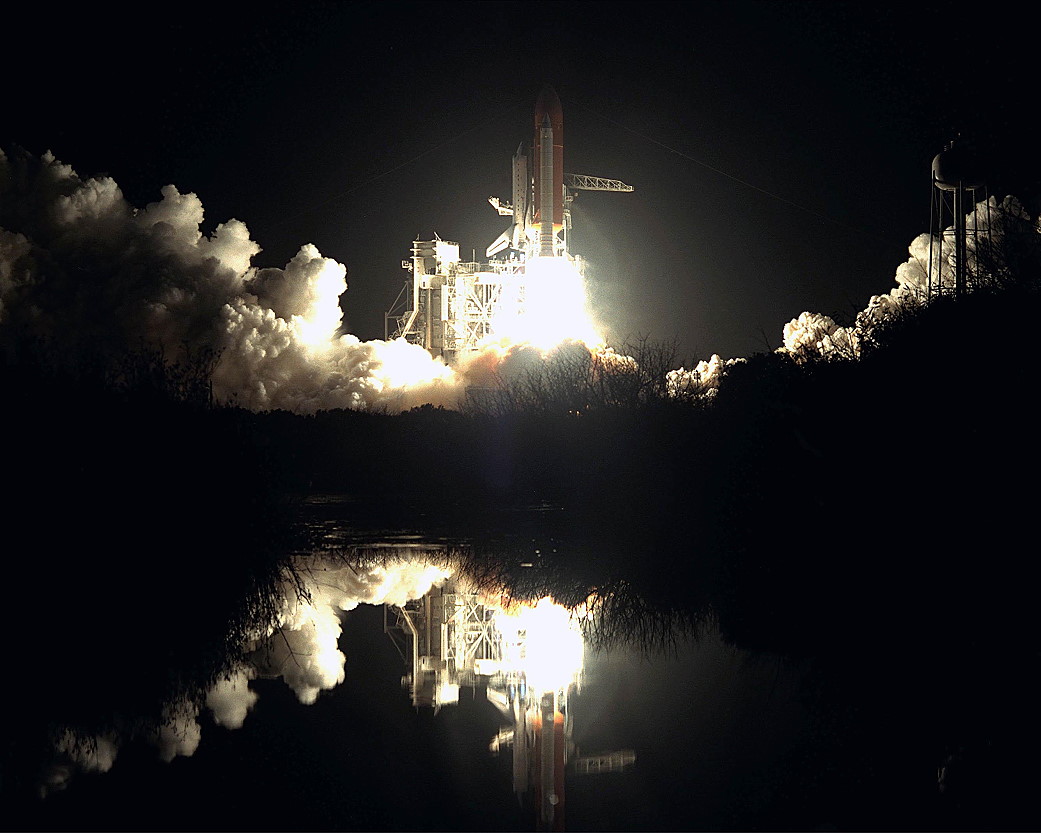
More than three decades ago, on the evening of 26 November 1985, shuttle Atlantis roared into the night to begin the week-long voyage of Mission 61B. Her seven-member crew—Commander Brewster Shaw, Pilot Bryan O’Connor, Mission Specialists Sherwood “Woody” Spring, Mary Cleave and Jerry Ross and Payload Specialists Charlie Walker and Rodolfo Neri Vela—deployed three communications satellites and performed two spacewalks, as well as marking the second shuttle flight to launch in the hours of darkness. Over the following quarter-century, five more shuttle missions would launch at night in November, creating an artificial dawn for hundreds of thousands of spectators along the Florida coastline.
Video Credit: NASA
“It was a perfect night,” Woody Spring remarked in his post-flight comments, of that Tuesday evening, 32 years ago. “We had a full moon, the day before Thanksgiving, severe, clear, not a cloud in the sky. It was a gorgeous night!” Only a few months previously had the 61B crew learned that theirs would be a nocturnal launch and, in the words of Brewster Shaw, the only “unusual” facet of their customary walkout from the Operations & Checkout Building at the Kennedy Space Center (KSC) in Florida was the fact that they did so at the cusp of sundown. The dusky orange glow of early evening glinted on the shiny surface of the Astrovan as the seven astronauts began their journey to historic Pad 39A for launch. In addition to STS-8 and the flight of Apollo 17 to the Moon, this would be the United States’ third launch in darkness.
Aboard Atlantis, the “window seats” on the shuttle’s flight deck were occupied by Shaw and Bryan O’Connor at the front, with Mary Cleave behind and between them, serving as flight engineer, and Jerry Ross to her right side. Spring, together with Charlie Walker and Rodolfo Neri, was seat in the windowless middeck, with only a row of lockers in front of his face for ascent. As T-0 neared, O’Connor glanced to his left to witness Shaw remove his gloves and wipe sweat from his hands. Mission 61B would be O’Connor’s first spaceflight, whilst Shaw had flown one previous voyage into orbit. “Oh my God,” O’Connor thought. “My commander, who’s been through this before…his hands are sweating! Why aren’t mine sweating? I need to be nervous now, if he’s nervous.”

The sound of Atlantis’ trio of Space Shuttle Main Engines (SSMEs) igniting was, said Spring, akin to a roomful of lions roaring, right behind him. “And you can feel it,” he remembered. “This vehicle’s alive. Then the main engines gimbal, getting ready. From the moment of main engine start, you get 1.5 seconds where the vehicle actually swings about three degrees of arc, then comes back again, then the Solid Rocket Boosters ignite.” With the force of a sledgehammer to the backs of their seats, the astronauts were pushed away from Pad 39A in what Spring could only describe as “a barn-burner”.
After the mission, Shaw would note that Atlantis’ rousing ascent was seen from as far away as the Carolinas to the north and the southern tip of Florida to the south. Inside the cockpit, the rise to orbit was rattling and reminiscent of a train wreck at times. Through his window, O’Connor saw the Moon, right dead-center, but the glow from the boosters and the shuttle’s engines eliminated any chance of seeing any stars. For the rookie pilot, a moment of significance came two minutes into the flight, when the solids were jettisoned, their separation motors flashing across the windows, as orange flame enveloped the whole forward end of the orbiter. After that, the G-levels settled from 2.5G to around 1G, with O’Connor describing a “long, continuous push” to orbit under the SSMEs’ impulse.

Any chance of another night launch was lost in the wake of the Challenger disaster, but in November 1989 and November 1991 the crews of STS-33 and STS-44—both Department of Defense missions and both featuring veteran astronauts Fred Gregory and Story Musgrave—also launched in the hours of darkness. On both flights, Musgrave served as the flight engineer, seated behind the commander and pilot, and the presence of a mirror on the wrist of his pressure suit allowed a unique view of launch through the shuttle’s overhead windows. From this vantage point, Musgrave could see directly into the launch pad’s flame trench and, as the shuttle gained altitude, his perspective broadened to offer a view of Florida in its entirety, lit up “like a flashbulb”. For Fred Gregory, the commander of STS-33 and STS-44, the separation of the boosters at two minutes was so intense that he was convinced he was looking directly into a furnace.
Although several shuttles flew into the night in the following years, the next November nocturnal launch did not come until 2000, when Endeavour roared aloft to begin her STS-97 mission to the International Space Station (ISS). Weather conditions at the Cape were reportedly so clear that the shuttle’s rise to orbit was visible as far north as New York City. In November 2002, just two months before the loss of Columbia, the astronauts and cosmonauts of STS-113 launched into the night, to be followed, more recently, by the crew of STS-126 in November 2008.





